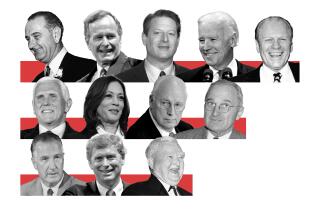Op-Ed: Trump’s 45% tariff on Chinese goods is perfectly calculated
- Share via
As a policy advisor to the Donald Trump campaign, I frequently get asked whether he is serious about imposing a 45% tariff on Chinese imports. Skeptics cry “protectionism” and warn of a trade war.
Let’s set the record straight. Trump will impose countervailing tariffs not just on China, but on any American trade partner that cheats on its trade deals using practices such as currency manipulation and illegal export subsidies. Such tariffs are not protectionist but rather defensive — and consistent with actions taken by American presidents from George Washington to Ronald Reagan. Indeed, one of the first bills Washington signed was a tariff, which Alexander Hamilton justified as a necessary defense against a mercantilist Europe.
Is a 45% tariff too high? When Japan flooded global markets with underpriced computer chips in the late 1980s, Reagan slapped a 100% tariff on semiconductors, plus high-end computers and TVs. The total tariffs were based on the economic injury suffered by the U.S. semiconductor industry as result of Japan’s cheating on a trade agreement. This is the kind of flexible case-by-case approach that a Trump White House, Treasury Department, Department of Commerce, and U.S. trade representative would use.
Still, Trump’s suggestion of a 45% tariff on Chinese imports would, by my calculations, be an appropriate level. More than 10 years ago, I began analyzing exactly how China’s state-run industries significantly undercut foreign manufacturers and found that lower labor costs accounted for only 39% of China’s price advantage. Five other unfair trade practices — the aforementioned illegal export subsidies and currency manipulation along with intellectual property theft and lax worker safety and environmental regulations — are the bigger story.
For example, China’s central bank keeps the yuan undervalued, thereby over-stimulating their exports while discouraging U.S. exports to China. Such blatant currency manipulation contributes significantly to a $365-billion trade deficit last year with China that would not exist in a freely floating exchange rate world.
Similarly, when China simply steals the intellectual property behind U.S. technology — and avoids incurring substantial research and development costs — it gains a huge advantage in key industries like autos, biotechnology, and pharmaceuticals. Likewise, when Chinese companies evade the environmental and worker safety costs imposed on American industry, made-in-China stuff can get even cheaper.
China has been waging an undeclared trade war on the U.S. since joining the World Trade Organization in 2001.
When I added up the effects of such practices in China in 2006, they accounted for 43.7% of the artificially low price of Chinese manufactured goods — almost exactly the amount of Trump’s proposed tariffs.
In the decade since my study was conducted, China’s cheating has only worsened and become more institutionalized. For example, the bipartisan Commission on the Theft of American Intellectual Property in 2013 estimated that the U.S. loses more than $300 billion a year to intellectual property theft and blames China for 50% to 80% of the problem. The Peterson Institute for International Economics in 2012 attributed “half or more of excess U.S. unemployment” to currency manipulation and identified China as “by far, the largest” currency manipulator. Since 2009, the U.S. trade representative has taken 13 cases against China to the World Trade Organization. The most recent, filed just last week, targeted illegal export duties on raw materials like copper, lead and and tin.
Meanwhile, the unfair trade advantages China reaps from lax environmental and health and safety regulations are written in blood: More than 60,000 Chinese workers perished in workplace accidents in 2014 and up to a half-million people die prematurely because of China’s horrific air pollution.
China has been waging an undeclared trade war on the U.S. since joining the World Trade Organization in 2001. The casualties are obvious: More than 50,000 American factories shuttered. Zero gains in real household median income. Our annual GDP growth rate cut almost in half since 2001 compared with the last half of the 20th century.
For Trump, steep tariffs are a strategic negotiating strategy to stop China, or any other country, from cheating on international trade deals. His broader goal is to eliminate our massive trade deficit, jumpstart GDP growth and create millions of new jobs. That in turn will boost income levels and generate the tax revenues necessary to pay for the infrastructure, social services, and defense needs of the greatest nation in the world.
Peter Navarro is an economics professor at the UC Irvine business school and the author of “Crouching Tiger: What China’s Militarism Means for the World.”
Follow the Opinion section on Twitter @latimesopinion and Facebook
More to Read
A cure for the common opinion
Get thought-provoking perspectives with our weekly newsletter.
You may occasionally receive promotional content from the Los Angeles Times.







